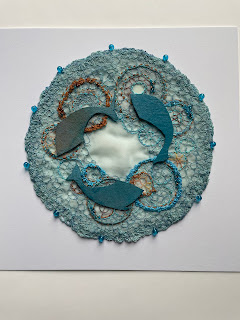The final flourish!
As a member of the Stitched Textile Artists I have enjoyed creating an installation presenting objects relevant to the theme 'Collections' which will be part of a body of work exhibited by STA at ACEarts Gallery, Somerton, Somerset in November / December 2024.
To summarise, my work represents a collection of exquisite lace bobbins and lace motifs worked by and entrusted to me by my Aunt. These, plus vintage family photographs featuring my Aunt and my mother playing as children plus my Aunt's poetry capture moments in time. I have been inspired to preserve these precious memories and their meaning within a child's dress using a process of printing, altered photographs, collage, layering and stitching thus ensuring their safe keeping.
The dress is accompanied by a hand crafted book to tell the story of the project's conception.
The front of the child's dress:
The bodice is composed of an original vintage photograph as a base layer over which I have laid the same image printed onto cotton organdie, cut outs of the girls plus a free machine stitched outline also worked on cotton organdie - all of which together create an impression of time passed and lingering memories. I have also incorporated within the layers images of the lace motif which originally inspired me to bring the concept of the project together.
The girls' dresses on the photo feature some beautifully embroidered daisies and so I have worked these by hand within the bodice, skirt and sleeves using eyelet and lazy daisy stitches.
The waistline is accentuated by some machine wrapped cord couched into place from which hang my representation of the lace bobbins crafted with papier mache and wrapped with cotton thread and beads.
My Aunts love of poetry is demonstrated around the dress hem, on this occasion she has quoted Shakespeare but a selection of her poetry is also featured in the book accompanying the dress.
The back of the dress:
The back of the dress is plainer but the bodice features my interpretation of my favourite lace motif worked by hand using a cut work technique which encloses another vintage photograph of my mother and my aunt.
Display of the dress as a centrepiece
My idea is for the dress to be suspended from above inviting visitors to walk around enabling them to view the dress from both front and back. On the table top below the dress I plan to display the hand crafted book to accompany the dress along with artefacts which are relevant to my collections theme.
I have added strips of my favourite poem composed by my Aunt worked in stem stitch and decorated with hand stitched daisy chains along the edges of the table. The daisies are worked as before but connected with a detached chain stitch.
The book
The book is hand crafted and tells the story of the project's conception; it is featured in the previous chapter page by page.
Also featured on the table top:
The original lace bobbins:
Sewing paraphernalia: Vintage cotton reels, needle and thread, thimble, scissors and daisies overflowing from a vintage glass pot. Plus some exquisite porcelain roses crafted by my aunt. These are enclosed in a glass dome to protect and keep them secure.
Delicate bag fashioned from 2 lace doilies:
Ideas for the customised vintage picture frame to present the original vintage photo:
The finished frame:
Customised vintage picture frame to present my artist statement
The exhibition
The exhibition at ACE ARTS Somerton, Somerset.


































































